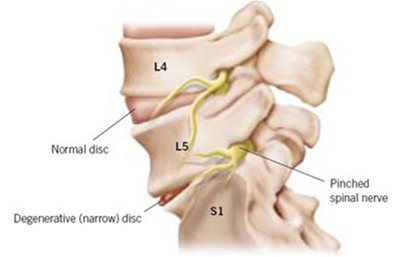Foraminal Lumbar Stenosis
Foraminal stenosis is a condition impacting the nerves in the spine. When there’s narrowing in the spine, it can cause the spinal nerves to compress. For some individuals, they may not experience any discomfort, whereas others could potentially experience pain in various areas of the body.
What Are the Symptoms of Foraminal Lumbar Stenosis?
There are 33 vertebral bones within your spine. In a healthy spine, there is more than enough room for nerve roots to pass through and move out to different areas of the body. These spaces where the nerves enter and exit are referred to as foramina. The foramen, which is formed by the facet joint, can sometimes either narrow or get blocked — which then compresses the nerves. This issue then leads to foraminal stenosis.
Symptoms of Foraminal Stenosis
If you are suffering from foraminal stenosis, you could experience a wide range of symptoms, depending on factors like how compressed the nerves are, how narrow the foramen has become and where the condition is manifesting in your back.
For example, if the foramen in your neck are affected, the discomfort and pain will likely be more concentrated in your:
- Arms.
- Fingers.
- Neck.
- Shoulders.
If the issue is in the lumbar spine, you’ll probably feel it more in areas like your:
- Back.
- Buttocks.
- Feet.
- Toes.
- Thighs.
- Knees.
You may experience symptoms like:
- Burning or a “pins and needles” sensation.
- Trouble with walking in a straight line.
- Numbness and tingling.
- Either a dull or sharp pain.
- Severe back pain.
- Trouble standing.
- Arm and leg weakness.
Causes of Foraminal Stenosis
Most of the time, foraminal stenosis occurs as a result of the natural aging process. However, along with degenerative causes, there are several other common origins of this condition, including:
- Bulging discs.
- Facet disease.
- Herniated discs.
- Genetics.
- Osteoarthritis.
- Paget’s disease.
- Spinal injuries.
- Spondylolisthesis.
- Thickened spinal ligaments.
- Tumors.
There are also various risk factors that could predispose you to foraminal stenosis, such as leading a sedentary lifestyle, smoking or being obese.
What Options Are Available for Foraminal Stenosis Treatment in Central New Jersey?
While it can be difficult to deal with daily, there are several treatment options available for foraminal stenosis — some of which can even correct the condition.
Depending on the extent of your condition, both nonsurgical and surgical spine treatment options are available:
- Nonsurgical treatment: As a first line of treatment, your medical professional may recommend nonsurgical options like wearing a back brace or doing regular stretching and strength training. Taking over-the-counter pain medication, like analgesics or anti-inflammatory drugs, can help provide relief as well.
- Surgical treatment: Sometimes, nonsurgical treatment may not offer enough relief. When this happens, your medical professional may recommend minimally invasive surgical treatments like foraminoplasty, laminotomy or discectomy.
At Spine Institute of North America (SINA), our team will take the time to learn more about your medical history, current symptoms and previous treatments to provide an accurate and comprehensive diagnosis. With physical examinations and tests like X-rays, CT scans and MRIs, our medical professionals will be able to get a clearer view of your spine, which will help guide your treatment approach.
By choosing the least invasive procedure and providing effective follow-up care, we’ll help you live your life to the fullest — free from discomfort and pain.
Minimally Invasive Surgery Options at Spine INA
While doctors mainly treat mild foraminal stenosis with nonsurgical methods, serious cases might need surgical intervention. Spine INA offers various surgical treatments for severe foraminal stenosis and can provide the appropriate treatment for the underlying cause of your stenosis.
We treat various cases of the condition — including bilateral foraminal stenosis, in which the foramen narrows on both sides of the spine — through minimally invasive spine surgery (MISS). We offer the following MISS procedures:
Endoscopic Foraminoplasty
Surgeons perform an endoscopic foraminoplasty to alleviate pressure on the spinal nerves or nerves passing through the foramen. The procedure relies on specially designed surgical instrumentation to remove bone overgrowth from the foramen, creating more space for nerve endings to pass through.
- The procedure: After you’ve received local anesthesia, a surgeon will make a small, 1/4-inch incision near the narrowed or blocked foramen. The surgeon will insert a tube into the incision and then guide an HD camera through the tube to the painful area. This helps your physician get a closer look at the area. With the help of microscopic surgical instruments, your surgeon can remove bulging discs and scar tissue that irritate the spinal cord. They will also decompress the foramen with a radiofrequency probe.
- Recovery time: Endoscopic foraminoplasty is one of the least invasive spine surgeries. With only a small incision, your recovery time is much less than the 12-month recovery period for traditional surgery. While recovery time for this MISS treatment varies, most patients start physical therapy on the day of their surgery.
Endoscopic Laminotomy
While this procedure does not solely treat foraminal stenosis, it can alleviate pressure on the spinal cord or nerve roots. An endoscopic laminotomy targets the lamina (the bony arch of the vertebrae). During the procedure, a surgeon removes some of the lamina to reduce pressure.
- The procedure: Your surgeon will use a small guidewire to locate the surgical site. Once they identify the surgical site, they will place a dilator over the guidewire. To create a pathway to the vertebrae, your surgeon will place a tube over the dilator and use specialized instrumentation to remove the bone overgrowth and decompress the spinal cord and foraminal area.
- Recovery time: This outpatient procedure takes just over an hour to complete. Because this minimally invasive treatment causes less tissue trauma, patients experience less postoperative pain. Your doctor will discuss the recovery process and advise on the best time to resume daily activities.
Endoscopic Discectomy
If a herniated disc contributes to your foraminal stenosis, your surgeon might suggest an endoscopic discectomy. This procedure removes a herniated or bulging disc that exerts pressure on nerves.
- The procedure: Your surgeon will make a 1/4-inch incision near the herniated disc and keep the cut open with a dilator. Then, your surgeon will use a small tube to guide an HD camera to the problematic area. With a close-up view of the herniated disc, they can accurately remove it.
- Recovery time: Generally, patients can return home an hour after their surgery. Those with sedentary jobs can usually return to work within a day or two, while those who move around more can return in four to six weeks.
MISS Post-Operative Recovery
Many of our patients are surprised by how quickly they are able to recover after their procedure. Most patients are able to get out of bed after about an hour and are cleared to go home just a short while later. You may have some pain at the incision site, but some patients report little or no pain. Be sure that you clear any physical labor or resumption of your normal activities with your doctor first.
You might need to take some mild pain medication for a little while as your body recovers. Your doctor will give you instructions for at-home aftercare, including exercises to help you retain your flexibility. If you experience a high level of pain or have any other concerns, you should contact our office right away.
What Is the Long-Term Diagnosis for Foraminal Stenosis Treatment?
Certain foraminal stenosis treatment options, such as our minimally invasive surgical procedures, provide long-term treatment. The effect can last for years as long as it’s followed with effective physical therapy.
What Is the Success Rate for Foraminal Stenosis Treatment?
The success rate reported for surgical treatment like lumbar laminectomy to relieve pain from foraminal stenosis is quite high. After a laminectomy, about 80% of the patients will have a marked improvement in their ability to perform their normal daily activities. The discomfort and pain, including arm and leg pain connected with the condition, also diminish rapidly.
Discover Minimally Invasive Back Pain Treatment at Spine INA
No matter the extent of your foraminal stenosis, our experienced and caring providers and surgeons will help you find the right foraminal stenosis treatment. Contact us today to make an appointment so you can take the next steps to relieve your pain and revive your life.











